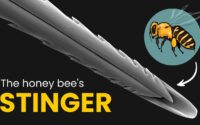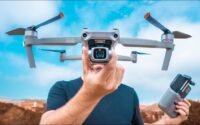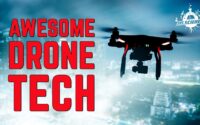Capturing the World from Above: The Power, Rise, and Future of Aerial Photography with Drones
The Power of Drones: Capturing Moments Through Aerial Photography
One of the most significant advantages of using a drone for aerial photography is the unique viewpoint it offers. By soaring above the ground, drones can capture scenes that were previously inaccessible or required expensive equipment, such as helicopters. Whether it’s a majestic landscape, a bustling cityscape, or an event from a bird’s-eye view, drones provide a fresh and captivating angle.
In addition to perspective, drones excel in capturing intricate details. Equipped with high-resolution cameras, they can produce sharp and vibrant images with impressive clarity. This enables photographers to document subjects with remarkable precision, showcasing textures, patterns, and colors that might go unnoticed from the ground. The level of detail captured by drones adds a whole new dimension to storytelling through photography.
Furthermore, drones offer unparalleled maneuverability, allowing photographers to navigate through challenging environments and capture dynamic shots. With their nimble movements, drones can weave through tight spaces, fly low to the ground, or ascend to great heights with ease. This versatility empowers photographers to experiment with composition, creating visually striking and dynamic photographs.
Moreover, drones have made aerial photography more accessible and cost-effective. Previously, capturing aerial images required substantial resources and permits. Now, with consumer-grade drones readily available, photographers can effortlessly explore the possibilities of aerial photography without breaking the bank. This accessibility has democratized the art form, enabling individuals from various backgrounds to express their creativity through aerial imagery.
The Rise of Aerial Photography
Aerial photography has experienced a remarkable rise in popularity, thanks to advancements in drone technology. – The ability to capture stunning images from the sky has become more accessible than ever before. – Drones equipped with high-resolution cameras offer unique perspectives and breathtaking views.
With their nimble maneuverability and compact size, drones can reach places that were once only accessible by helicopters or airplanes. – This opens up new creative possibilities for photographers and enthusiasts alike. – The use of drones in aerial photography has revolutionized industries such as real estate, cinematography, and land surveying.
One of the advantages of using drones for photography is their ability to capture images from different altitudes and angles. – Aerial shots can provide a comprehensive view of landscapes, cityscapes, and events. – Drones can capture images that were previously unattainable, revealing a whole new world from above.
Moreover, drones allow photographers to document and explore environments that may be hazardous or difficult to access. – They can be deployed for search and rescue missions, environmental monitoring, and even scientific research. – Drones have proven to be valuable tools in various fields, enabling professionals to gather data and conduct analysis from above.
However, drone photography also raises concerns regarding privacy and safety. – Regulations and guidelines are in place to ensure responsible and ethical drone usage. – Pilots must be aware of no-fly zones, respect privacy boundaries, and prioritize safety above all.
The Technical Marvel: How Drones Capture Images
Drones have revolutionized the way we capture images, offering a technical marvel in aerial photography. With their advanced capabilities and maneuverability, drones can take breathtaking pictures from unique perspectives. These flying devices are equipped with high-resolution cameras that capture stunning images with remarkable clarity. The versatility of drones allows photographers to explore various angles and compositions, resulting in captivating shots. Furthermore, drones provide access to locations that were previously difficult or impossible to reach, such as remote landscapes or towering structures. The ability to fly at different altitudes and speeds enables photographers to capture dynamic shots with ease. Moreover, drones can be programmed to follow predefined flight paths, ensuring precise positioning for optimal image capture. The remote control feature allows photographers to adjust camera settings in real-time, maximizing image quality. Drones also offer the convenience of instant image preview on a connected device, eliminating the need to wait until after the flight to assess the shots. Post-processing options further enhance the captured images, allowing for fine-tuning and creative editing. Additionally, drones are equipped with stabilization mechanisms that reduce blurriness caused by wind or vibrations, resulting in sharp and professional-looking photographs. The portability of drones makes them a practical tool for photographers on the go, enabling them to capture stunning images during travel or outdoor adventures. In conclusion, the technological marvel of drones has revolutionized the world of photography, allowing us to capture breathtaking images from previously unattainable perspectives. The capabilities, versatility, and convenience offered by drones make them an essential tool for photographers seeking to push the boundaries of their craft.
Applications of Aerial Photography
Aerial photography has witnessed a significant transformation with the advent of drone technology. Drones, also known as unmanned aerial vehicles (UAVs), can capture high-resolution images from various altitudes and angles, providing valuable data for a wide range of applications.
-
Urban Planning: Drones equipped with cameras can capture aerial images of cities, enabling urban planners to assess land use patterns, monitor infrastructure development, and make informed decisions for future urban development.
-
Agriculture: Aerial photography allows farmers to assess crop health, detect irrigation issues, and identify pest infestations. This information enables targeted interventions, optimizing crop yield and minimizing resource usage.
-
Environmental Monitoring: Drones can capture images of remote or inaccessible areas, aiding in environmental monitoring. This includes tracking deforestation, studying wildlife habitats, and monitoring natural disasters.
-
Real Estate: Aerial photographs provide an impressive visual representation of properties for real estate listings. Potential buyers can get a better understanding of the property’s location, surroundings, and features.
-
Construction and Surveying: Drones equipped with cameras and LiDAR sensors can capture accurate topographic data and monitor construction progress. This improves project management, reduces costs, and enhances worker safety.
-
Archaeology: Aerial photography assists archaeologists in identifying ancient structures, mapping archaeological sites, and conducting surveys to understand historical landscapes without disturbing the ground.
-
Disaster Response: Drones can quickly assess the extent of damage after natural disasters, providing valuable information for rescue operations and aiding in post-disaster recovery efforts.
-
Filmmaking and Photography: Drones equipped with high-resolution cameras offer filmmakers and photographers unique perspectives and stunning aerial shots, enhancing the visual storytelling process.
-
Wildlife Conservation: Aerial photography helps in tracking wildlife populations, identifying animal migration patterns, and monitoring poaching activities. This data aids in the conservation and protection of endangered species.
-
Infrastructure Inspection: Drones can inspect tall structures, such as bridges and towers, capturing detailed images for structural analysis and maintenance planning. This improves safety and reduces inspection costs.
Advantages and Limitations of Drone Photography
Drone photography, with its aerial perspective, offers numerous advantages in capturing stunning images. Firstly, drones can reach inaccessible or dangerous locations, allowing photographers to capture unique angles and viewpoints. Moreover, the ability to fly at different altitudes enables the creation of breathtaking landscape shots. Additionally, drones equipped with high-resolution cameras can capture fine details, resulting in high-quality images suitable for various purposes. Furthermore, drone photography provides cost-effective solutions compared to traditional aerial photography methods, as it eliminates the need for expensive aircraft or helicopters.
However, drone photography also has its limitations. One major limitation is the dependence on weather conditions. Strong winds, rain, or fog can significantly impact the stability and quality of the captured images. Moreover, the limited flight time of drones restricts the duration of aerial photography sessions, requiring careful planning to maximize shooting opportunities. Furthermore, drones are subject to aviation regulations, and obtaining the necessary permits and licenses can be a complex process. This can limit the flexibility and spontaneity of drone photography projects.
Another limitation of drone photography is the potential invasion of privacy. Drones equipped with cameras have raised concerns regarding their use for surveillance or intrusive purposes. To address these concerns, many countries have implemented regulations to govern the use of drones and protect individuals’ privacy rights.
The Future of Drone Photography
Drones offer unique perspectives and angles that were previously impossible or expensive to achieve. With their agility and ability to fly at different altitudes, drones capture stunning aerial shots and provide a fresh outlook on landscapes, architecture, and events. They enable photographers to go beyond traditional ground-level photography, delivering captivating visuals that stand out.
The quality of drone cameras continues to improve, allowing for high-resolution images and videos. Advanced features like stabilizers and gimbal systems ensure smooth and steady shots, even in challenging conditions. Additionally, drones can be equipped with various lenses, filters, and accessories, enhancing their versatility and creative potential.
Drone photography has found applications in numerous fields, including real estate, tourism, journalism, and environmental monitoring. In real estate, aerial shots give potential buyers a comprehensive view of properties, showcasing their features and surroundings. In tourism, drones capture breathtaking footage of destinations, enticing travelers to visit. Journalists and news agencies utilize drones to cover events from unique angles, providing a different perspective to their audience. Environmentalists and researchers benefit from drones to survey and monitor landscapes, wildlife, and natural resources.
As technology advances, we can expect drones to become even more intelligent and autonomous. Artificial intelligence and machine learning algorithms are being integrated into drones, enabling them to perform tasks autonomously and assist photographers. Features like object tracking, obstacle avoidance, and automated flight paths enhance efficiency and safety.
Despite the positive impact of drone photography, there are challenges to address. Privacy concerns and regulations regarding airspace and flight restrictions require careful consideration. Responsible drone operation and adherence to local laws are crucial to ensure the safety and privacy of individuals and communities.



